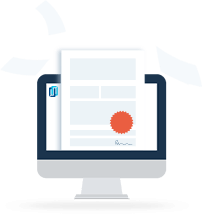
Construction is one of the only industries that rely heavily on “physical payment.” Maybe it’s time to do something different. In 2019, it took construction businesses an average of 83 days to get paid after invoicing. No one should ever have to wait that long to get paid for the work they do! If waiting for the GC or property owner to issue a paper check is holding you back, ask them if they would be willing to use a different payment method. Here are some alternatives to paper checks that can help construction businesses get paid faster. These payment options make it easier for customers to pay – and easier for contractors and suppliers to collect.
Construction relies too heavily on paper checks
There are a number of reasons why it takes so long to get paid in construction. Sometimes, payment delays are valid. Maybe you didn’t give enough detail on your payment application. Maybe the GC had a dispute about the quality of your work. The property owner may not even realize that you’re on the job and need to get paid!
Sometimes, however, even when you do everything right, and the GC or property owner has approved your pay application, you still have to wait for the paper check to arrive in the mail – and then wait a few more days for the check to clear. Fortunately, the delay caused by the construction industry’s reliance on paper checks is largely preventable.
Read more: The construction business guide to getting paid (on time)
Compared to direct deposit or online payment options, paper checks take a long time to process. They can easily get lost or delayed in the mail, and often require several people to come to the office before they can be sent.
Joint checks are a unique arrangement
Of course, one practice particularly unique to construction is the use of joint check agreements. Because joint checks can protect a subcontractor’s payment on a project, they’re a popular option when working on a project where they’re concerned about getting paid. A joint check requires the signature of two parties – typically, the GC and their subcontractor or supplier – before the GC can deposit it. When used correctly, a joint check can give the sub more control over the process, ensuring that the GC pays the parties under them on time.
Construction Payment Options: Alternatives to paper checks
For projects that don’t use joint checks, contractors and suppliers have more payment options. If you would like your money to hit your bank account in days instead of weeks, you can offer payment methods that will ease the payment process.
Learn more: How to make the leap to digital payments
Direct Deposit (ACH)
Direct Deposit uses ACH (Automated Clearing House) fund transfers to move money directly from one bank account to another. They offer the GC or property owner a way to transfer funds directly from their bank account to your account. There is no need for a paper check, no card numbers, and no expiration dates to track. Transfers can be completed in 3-5 business days and their processing fees are often less than for credit cards or wire transfers.
To start accepting payments by ACH, you will need to sign up with an ACH processor (usually your bank or another merchant services provider). The transfers are overseen by NACHA, the National Automated Clearing House Association, which is the governmental entity responsible for overseeing and regulating the ACH network.
ACH transfers can be started by either party. Make sure you have a way to keep bank account information private and secure before you start. Transfer amounts may be subject to daily limits, so be sure to research them if you are planning to transfer large sums of money.
Direct deposit costs
Transfer fees will vary by processor, but usually run $0.25 to $0.75 per transaction (or 0.5-1% if charged on a percentage basis).
Wire Transfer
Wire transfers are similar to ACH transfers, in that they are direct bank transfers from one party to another. Wires are usually processed directly between banks, so there is no third-party service involved. Your customer simply tells their bank that they want to send you money, then gives their bank your account number and routing information.
Wires can be processed almost immediately, so funds are available on a same-day or next-day basis.
Wire transfer costs
Wires are typically more expensive than other forms of electronic payment. Fees for sending a wire vary by institution but can reach up to $60. Wire receivers are also charged a fee, though it is usually less than the sending fee. There aren’t any limits on the amount of money that can be sent via wire, as long as the funds are available in the sender’s account.
Credit Cards
Accepting credit cards can be a great way to make payment easier for your customers. Many accounting software programs (like Quickbooks or Wave) offer credit card processing as part of their services, so all you need to do is enroll with them and you’ll be on your way. Funds can be deposited into your bank account within 3-5 business days.
You can also sign up directly with a merchant services provider. These companies process the credit card payments and take care of moving the appropriate funds into your account.
Credit card costs
There is a fee for processing credit cards, of course. Be sure to shop around for the best rate. You can expect to pay 1.5-3.5% of each purchase. Generally, you can pass these charges on to your customers if accepting credit cards isn’t part of your normal payment procedures.
However, there are ten states that prohibit passing on credit card service fees: Colorado, Connecticut, Florida, Kansas, Maine, Massachusetts, New York, Oklahoma, and Texas. If you plan to charge your construction customers for paying by credit card, be sure to check your local laws first.
Peer to Peer Payments (P2P)
There are a growing number of apps that allow the transfer of money for little to no fees. PayPal, Venmo, and Square Cash are some of the most popular, though there are many others. These peer to peer (P2P) payment apps often allow you to request money from anyone with only a phone number or an email, reducing the confidential information that needs to be exchanged and protected.
Most apps are meant for smaller dollar amounts, but some have limits as high as $60,000 per day (PayPal). Their simplicity and low cost make them a great option if you provide service work or have smaller invoice amounts and want to offer your customers a quick way to pay without the hassle of exchanging bank account info or credit card numbers.
P2P costs
Many of these apps will make transfers for free, except when using a credit card. When a credit card is used, the standard credit card processing fees are charged. Transferring the money from the app to your bank account usually takes about 1-3 days, though some will transfer funds immediately for a small fee.
Better Ways to Get Paid Faster in Construction
Giving your customers options on how to pay your invoices provides them with more flexibility and the ability to pay without going through the usual office channels. Most of the payment options will cost you a bit of money for processing and some set-up time — but receiving payments quickly can make up for those small costs.
Ditching paper checks will likely save you some time, but construction businesses actually have a number of tools that are much more effective at speeding up payment.
Use payment penalties & incentives
Late or slow payments cost construction businesses a lot more than they realize. Contractors who don’t pass the costs onto their customers are effectively giving them an interest-free loan.
Tack a late payment penalty on to your invoices if they aren’t paid according to the terms you agreed upon. Most states actually have prompt payment laws that require property owners and GCs to submit payment within a certain period of time, or pay interest fees and other penalties.
You could also offer early payment discounts if your invoices are paid promptly (for example, within 10-15 days). Many material suppliers offer these types of early pay discounts. Make sure that you aren’t offering too steep a discount, however. You don’t want to give away all your profit in order to get paid a few days earlier.
Factor your construction invoices
Another option is to sign an agreement with a construction invoice factoring company. These companies pay you a reduced amount in exchange for your invoice amount. For a small fee, you can get paid in just a few days. When your customer makes the payment, it is sent to the factoring company. Using invoice factoring takes all the collections headaches off your plate, giving you cash up front and leaving you with more time to run your business.
Always, always, always: Protect your lien rights
A construction business’ right to file a mechanics lien may be the most powerful construction tool of all. Following a mechanics lien process virtually guarantees fast payment. Every step that you take to protect your lien rights – from sending preliminary notices to filing a Notice of Intent – is incredibly effective at getting contractors paid on its own.
In fact, construction companies that protect their payments this way rarely ever have to actually file a mechanics lien. It sends a strong signal to the person who controls the purse strings – that you take your work seriously, and you’re willing to go to bat for your employees’ paychecks.

Protect & speed up every payment
Learn how Levelset can help you easily manage your lien rights on every project to ensure your payments are always protected.
Contractors have the power to get paid faster
Collecting payment in construction can be a headache-inducing task. It can be enough to make many contractors why they got into the business in the first place. However, there’s no good reason why getting paid has to take so long, or so much effort. When construction businesses use the right tools, getting paid gets a whole lot easier.
Ultimately, you have a right to get paid for the work you do. You shouldn’t have to take on debt – or worse, go broke – trying pay your employees and meet expenses while you wait for the money you’ve already earned.
